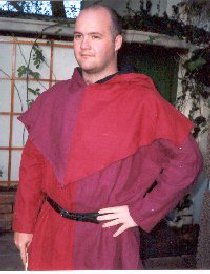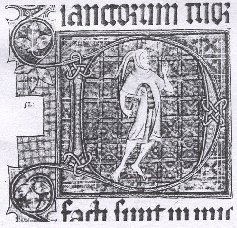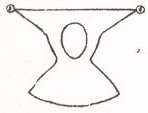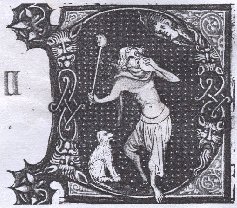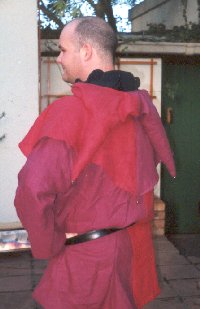|
Arts and Sciences entry, Shire Birthday, June XXXV.
The costume was made for Samson Mottley, mka Dylan Craig, who wore it at the event. THE MEDIEVAL JESTER
Figures (1)& (2): Illuminated initial Ds from 14th century Psalters, Psalm 53 According to Newton, the fool occupied a position of some importance in the royal courts of the fourteenth century; she gives several instances of the privileges and respect accorded the fool (Newton, 1980: 80), including elaborate headdresses and clothing. She also notes wardrobe accounts which record fools as receiving hoods as part of their allowance (1980: 81). As seen in the two Psalter examples (1 & 2) above, there is considerable variation in the dress of the fool; recurring themes include some kind of bauble or bladder, bare feet, and a hood, but these are by no means present in all depictions of fools. The tunic generally seems to be quite short; other examples show only a breech-clout worn with the hood (see Fig 7 below). In the two examples (Figs 1 & 2) above, the hoods variously have three or two points. According to Newton, the foolís hood was referred to as an aumuces in many accounts, a term which implies two points (Newton: 1980: 84). Although fourteenth century art is quite stylised, it seems likely that one of the hoods has points which are designed to stick straight up into the air (1), while the other allows them to droop (2). (1) has bells at the hood points and at the tips of the square-cut cape. The particolour example below also has bells. STYLEThe outfit I have chosen to construct is based on the standard fourteenth-century menís tunic and cape/hood combination, as seen below. The cape sits around the shoulders, presumably offering added warmth, with the hood attached. The long tail of the hood, seen below, develops easily into the stuffed and exaggerated multiple points of the jester's hood.
(3) Men from the Luttrell Psalter, mid 14th-century. As well as the cape and hood, the fourteenth century is also characterised by the use of particolour tunics; Houston reports this as "a favourite effect" of the century, giving examples in various British Museum manuscripts of the early and mid 14th century (1939: 95, 109). Among the colour combinations she reports are blue and fawn, red and white, blue and white. (The particularly loud combination of red and pink in my construction of a jesterís costume was a choice of its wearer). In addition, Houston reports at least one example of a jesterís costume with a particolour hood: see Fig 4, below.
(4) Jester figure from Bodlein MS 964, 1344, redrawn by Houston CONSTRUCTIONThe tunic itself was a simple 14th-century particolour, worn belted, as in the Luttrell Psalter illustration, (3) above. The distinctive feature of the costume is the hood, which was more complex. Some elements of construction are obvious from the pictures; I have, for example, taken the square-cut shoulder cape with bells at the shoulders and central point, from the left-hand Psalter picture, (1) above. Likewise, the two-pointed hood follows both the right-hand Psalter illumination (2) and the Bodlein MS picture redrawn by Houston, (4) above. Since the pictures seem to suggest a certain amount of stiffness in the points, I stuffed the points and sewed them closed. Houstonís chapter on the construction of fourteenth-century garb gives a hood structure similar to Fig (4) above, with the cape and headpiece in one piece (see below). I chose to cut them separately as I didnít have the necessary fabric left over to cut them in one piece.
(5) Houstonís construction, and 6) My adaptation In addition, given that we are in Africa and heat is often a problem, I deliberately cut the hood so that the wearer can push it back over his shoulders, in the manner seen in dress of another Psalter fool, (7) below. This entailed leaving an opening at the throat, which is closed with a button and loop so that the hood sits closely around the face when worn. Because of this requirement, I also lined the hood in black, which contrasts well and looks good when worn open. Newton suggests that some fourteenth-century hoods may have had a fur lining (1980: 56), but that seems a bit excessive for this climate!
(7) Another initial letter Fool from a 14th century psalter, and (8) view of my construction showing hood worn open. FABRIC: the outfit is made entirely from linen, with the exception of the hood, which is a light wool. These are both authentic fabrics for this period, although I was unable to find a plain linen without the distinctive modern slub effect; medieval linens would have been evenly woven. The bells are plain metal and of a simple construction which doesnít look too different to what I can see from the pictures. BIBLIOGRAPHYMary G. Houston, Medieval Costume in England and France, 1939, London: Adam and Charles Black. Stella Mary Newton, Fashion in the Age of the Black Prince, 1980, Woodbridge: Boydell My thanks to Samson Mottley (Dylan Craig) for suggesting the project, consenting to model it for the A&S, and submitting to have pins stuck into him while I fitted the darned thing
|


